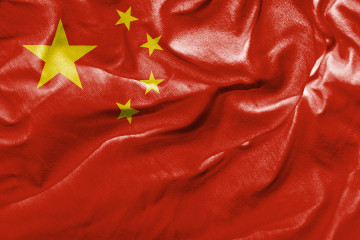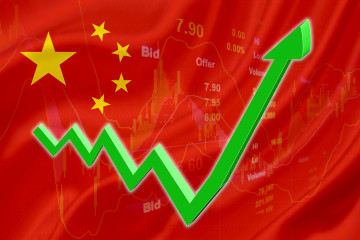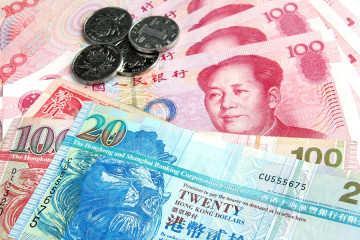China Is Getting Less and Less Bang for Its Credit Buck

©2016 Bloomberg News
O1867M6JTSEB
(Bloomberg) — Behind the numbers showing China’s continued slowdown at the end of last year lies a warning for Communist Party leaders who have been equally determined to embrace economic change and to ensure a rapid pace of growth.
The flashing yellow light: there’s less and less power behind policy makers’ stimulus. For each $1 in credit expansion, China added the equivalent of 27 cents of gross domestic product last year, the least since 2009, according to data compiled by Bloomberg from government figures released Tuesday. As recently as 2011, each $1 generated 59 cents.
The diminishing mileage for credit raises a conundrum for President Xi Jinping and his premier, Li Keqiang, of whether to let China slow further as they shut down surplus smokestack industrial capacity, or keep pumping liquidity. It also highlights the importance of financial-industry reforms — another ball the leadership is juggling.
“This will require rolling back preferences that tilt, and trap, the flow of investment in inefficient state enterprises,” said David Loevinger, a former China specialist at the U.S. Treasury and now an analyst at fund manager TCW Group Inc. in Los Angeles. “This is always challenging because the companies that stand to lose are big and powerful and the companies that stand to win are small and may not even yet exist.”
Debt Blowout
While the People’s Bank of China has implemented broad monetary relaxation, through interest-rate cuts and reduced bank required reserve ratios since late 2014, more of policy makers’ efforts have focused on a targeted channeling of funds. That’s in contrast to the type of hose-pipe stimulus that led to a debt blowout after the global credit crisis.
Fiscal policy shifted firmly into pro-growth mode in October and November with public spending up about 30 percent from a year earlier. Policy makers have singled out areas including shantytown redevelopment as priorities.
“With the space for and effectiveness of conventional monetary easing limited, the government will have to find new ways of bolstering demand,” Tom Orlik and Fielding Chen, economists at Bloomberg Intelligence, wrote in a report Tuesday.
Orlik and Chen expect more public spending increases, and an expanded rescue for local governments constrained by a debt hangover from the stimulus by predecessors to Xi and Li. They also see two more benchmark rate cuts by the PBOC in the first half of 2016.
Advanced Industries
Officials also are moving ahead with a push into advanced industries, such as planning to merge more than 40 entities working on plane engines into a group with 145 billion yuan ($22 billion) in assets, according to people familiar with the proposal.
China’s economy slowed in December, capping the weakest quarter of expansion since the 2009 global recession, as policy makers struggle to finesse a transition to consumer-led expansion. Full-year growth of 6.9 percent, in line with the government’s target of about 7 percent, was the least in a quarter of a century.
Meantime, non-financial corporate debt has surged to about 161 percent of GDP, most of it in the state sector, according to Zhou Hao, an economist at Commerzbank AG in Singapore.
’More Worrying’
“We see a large increase in indebtedness alongside declining profit growth,” Zhou said in a recent note. “What is perhaps more worrying from our perspective is that corporates increased their fixed-asset investments significantly as profit growth declined.”
Producer-price deflation is complicating matters for indebted companies as they struggle to pay off loans at the same time prices of their products fall. Factory-gate deflation has persisted for a record 46 months and the GDP deflator, a measure of economy-wide inflation, worsened to minus 0.5 percent last year.
To some analysts, that underscores the need for additional easing.
“Deepening of deflationary pressures require more decisive reflationary policies,” economists Julia Wang and Li Jing at HSBC Holdings Plc wrote in a report. “Both monetary and fiscal easing measures are needed to help support demand and anchor expectations.”
Rate Cuts
HSBC forecasts a quarter percentage point interest-rate cut and 1 percentage point reserve ratio reduction this quarter, plus a wider fiscal deficit target for the year.
Credit growth ended the year strongly, reflecting the government’s recent intensifying calls for stronger financial support to the economy and possibly a faster pace of financing for public projects, Wang Tao, chief China economist at UBS Group AG in Hong Kong, wrote in a note. She expects multiple RRR cuts to offset capital outflows, and two benchmark rate cuts to rein in deflationary pressure and lower financing costs.
Data has shown a patchy response to stimulus so far. While China’s aggregate financing in December surged the most since June as companies turned to alternative sources for credit, banks remained reluctant to lend.
“Expansionary monetary policy hasn’t translated into stronger growth momentum in the real economy,” said Xu Gao, chief economist at Everbright Securities Co. in Beijing. “At least in the short term we need some stimulus policies to maintain stable economic growth. If the government wants economic growth above 6.5 percent, well, you need some recovery in the industrial sector,” he said, referring to Xi’s goal of at least 6.5 percent average annual growth through 2020.
–With assistance from Ailing Tan, Scott Lanman and Enda Curran.
To contact Bloomberg News staff for this story: Kevin Hamlin in Beijing at khamlin@bloomberg.net To contact the editors responsible for this story: Malcolm Scott at mscott23@bloomberg.net Jeff Kearns






No Comment